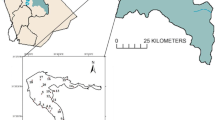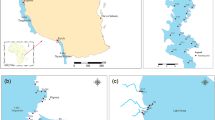Abstract
Temporal status and trends in water quality of Al-Wehda Dam, Jordan, from 2006 to 2012 indicate that the dam is subject to a combination of impacts from rainstorm and agricultural runoffs. It also revealed that mineral dissolution, sediment load, rainfall events, evaporation, and water-level fluctuation are the major contributors to variations in water quality. The water chemistry of the impounded Al-Wehda Reservoir showed that Na, Ca, Mg, HCO3, and Cl are the principal ions, reflecting the dominance of carbonate weathering, with some contribution of silicates. The pH values showed a cyclic pattern with highest values observed in the spring seasons. Total dissolved solids (TDS), Ca, Mg, and HCO3 are primarily related to leaching and evaporation, with elevated levels that occurred in the rainy winter months. In contrast, seasonal patterns in Na, K, Cl, and NH4–N contents showed decreased values in winter. Peaks in NO3–N observed in winter are strongly associated with agricultural runoff. Fluctuations in chlorophyll-a level were coincided with low ratio of total nitrogen (TN) to total phosphorus (TP). Seasonal variations in organic matter content were also apparent, with peaks that generally occurred in spring through early fall corresponding with high algal growth. On an annual basis, the vast majority of water quality data have generally declined, particularly, in 2011. However, it is not clear whether these decreases are related to change in management practices within the Yarmouk basin, or protective measures have been implemented. Comparison of in-lake and post-dam water quality from 2009 to 2011 showed variation in concentrations, where Ca, HCO3, NO3–N, Mg, and TDS showed relatively greater post-dam values than in-lake water, whereas pH, Na, Cl, K, COD, BOD5, and chlorophyll-a were consistently lower in post-dam water. This comparison emphasizes the importance of self-purification capacity of Al-Wehda Dam in reducing some contaminants.


















Similar content being viewed by others
References
Al-Jayyousi, O. (1995). An analysis of future water policies in Jordan using decision support system. International Journal of Water Resources Development, 11, 315–330.
Al-Rawabdeh, A., Al-Ansari, N., Al-Taani, A. A., Al-Khateb, F., & Knutsson, S. (2014). Modeling the risk of groundwater contamination using modified DRASTIC and GIS in Amman-Zerqa basin, Jordan. Central European Journal of Engineering. doi:10.2478/s13531-013-0163-0.
Al-Rawabdeh, A., Al-Ansari, N., Al-Taani, A. A., & Knutsson, S. (2013). A GIS-based drastic model for assessing aquifer vulnerability in Amman-Zerqa groundwater basin, Jordan. Engineering, 5, 490–504.
Al-Taani, A. A., Batayneh, A., Mogren, S., Nazzal, N., Ghrefat, H., Zaman, H., et al. (2013). Groundwater quality of coastal aquifer systems in the eastern coast of the Gulf of Aqaba, Saudi Arabia. Journal of Applied Science and Agriculture, 8, 768–778.
Al-Taani, A. A., Batayneh, A., El-Radaideh, N., Al-Momani, I., & Rawabdeh, A. (2012). Monitoring of selenium concentrations in major springs of Yarmouk basin, north Jordan. World Applied Sciences Journal, 18, 704–714.
Al-Taani, A. A. (2011). Seasonal variations in water quality of Al-Wehda Dam north of Jordan and water suitability for irrigation in summer. Arabian Journal of Geosciences. doi:10.1007/s12517-011-0428-y.
American Public Health Association (APHA), American Water Works Association (AWWA) and Water Environment federation (WEF). (1998). Standard methods for the examination of water and wastewater (20th ed.). Washington DC: APHA.
Basnyat, P., Teeter, L., Lockaby, B. G., & Flynn, K. M. (2000). Land use characteristics and water quality: a methodology for valuing of forested buffers. Environmental Management, 26, 153–161.
Batayneh, A., Elawadi, E., Al-Taani, A. A., Zaman, H., Ghrefat, H., Nazzal, et al. (2014a). Integrated resistivity and water chemistry for evaluation of groundwater quality of the Gulf of Aqaba coastal area: implications for sustainable agriculture. Indian Journal of Applied Research. In Press.
Batayneh, A., Zumlot, T., Ghrefat, H., Nazzal, N., Qaisy, S., Zaman, H., et al. (2014b). Hydrochemical facies and ionic ratios of the coastal groundwater aquifer of Saudi Gulf of Aqaba: implication for seawater intrusion. Journal of Coastal Research, 30, 75–87.
Batayneh, A., Al-Momani, I., Jaradat, R., Awawdeh, M., Rawashdeh, A., & Ta’any, R. (2008). Weathering processes effects on the chemistry of the main springs of the Yarmouk Basin, north Jordan. Environmental Hydrology, 16, 20.
Branco, C. W. C., Rocha, M. I. A., Pinto, G. F. S., Gomara, G. A., & Filippo, R. (2002). Limnological features of Funil Reservoir (RJ, Brazil) and indicator properties of rotifers and cladocerans of the zooplankton community. Lakes & Reservoirs: Research and Management, 7, 87–92.
Chilton, J. (2006). Assessment of aquifer pollution vulnerability and susceptibility to the impacts of abstraction. In O. Schmoll, G. Haward, J. Chilton, & I. Chorus (Eds.), Protecting groundwater for health: managing the quality of drinking-water sources (pp. 199–241). London, UK: World Health Organization and IWA Publishing.
Cloot, A., & Ros, J. C. (1996). Modeling a relationship between phosphorus, pH, calcium and chlorophyll-a concentration. Water SA, 22, 49–55.
Dillon, P. J., & Rigler, F. H. (1974). The phosphorus—chlorophyll relationship in lakes. Limnology and Oceanography, 19, 767–773.
Dodds, W. K. (2006). Nutrients and the “dead zone”: the link between nutrient ratios and dissolved oxygen in the northern Gulf of Mexico. Frontiers in Ecology and the Environment, 4, 211–217.
Dodds, W. K. (2003). Misuse of inorganic N and soluble reactive P concentrations to indicate nutrient status of surface waters. Journal of the North American Benthological Society, 22, 171–181.
Duyzer, J. H., Verhagen, H. L. M. & Erisman, J. W. (1989). The deposition of acidifying substances at the Asselsche Heide (in Dutch), MT-TNO Rep. R 89/029, Delft, The Netherlands.
El-Radaideh, N., Al-Taani, A. A., Al-Momani, T., Tarawneh, K., Batayneh, A., & Taani, A. (2014). Evaluation of the potential of sediments in Ziqlap Reservoir (NW Jordan) for soil replacement and amendment. Lake and Reservoir Management, 30, 32–45.
Ferrier, R. C., Edwards, A. C., Hirst, D., Littlewood, I. G., Watts, C. D., & Morris, R. (2001). Water quality of Scottish rivers: spatial and temporal trends. Science of the Total Environment, 265, 327–342.
Fonseca, R., Barriga, F. J. A. S., & Fyfe, W. S. (1993). Suitability for agricultural use of sediments from the Maranhão Reservoir. In M. A. C. Fragoso & M. L. Beusichem (Eds.), Optimization of plant nutrition (pp. 665–671). Dordrecht: Kluwer Academic Publishers.
Forsberg, C., & Ryding, S. O. (1980). Eutrophication parameters and trophic state indices in 30 Swedish waste-receiving lakes. Archiv fuer Hydrobiologie, 89, 189–207.
Gaudet, J. J., & Muthuri, F. M. (1981). Nutrient relationships in shallow water in an African Lake. Lake Naivasha. Oecologia, 49, 109–118.
Gibbs, R. (1970). Mechanisms controlling world water chemistry. Science, 170, 1088–1090.
Guildford, S. J., Hendzed, L. L., Kling, H. J., Fee, E. J., Robinson, G. G. C., Hecky, R. E., et al. (1994). Effects of lake size on phytoplankton nutrient status. Canadian Journal of Fisheries and Aquatic Sciences, 51, 2769–2786.
Haddadin, M. (2006). Compliance with and violations of the unified/Johnston Plan of the Jordan Valley. In: Water in the Middle East: cooperation and technological solutions in the Jordan Valley, ed. D. Hambright, J. Rageb, and J. Ginat. University of Oklahoma Press, 249 pp.
Howard-Williams, C., & Howard-Williams, W. (1978). Nutrient leaching from the swamp vegetation of Lake Chilwa, a shallow African Lake. Aquatic Botany, 4, 257–267.
Kelly, S. (2009). Report on the Green and Watch Lakes sewage contaminated seepage detection study (p. 23). Kamloops, British Columbia: Environmental Protection Division, Ministry of Environment.
Levine, S. N., & Schindler, D. W. (1999). Influence of nitrogen to phosphorus supply ratios and physicochemical conditions on Cyanobacteria and phytoplankton species composition I the Experimental Lake Area, Canada. Canadian Journal of Fisheries and Aquatic Sciences, 56, 451–466.
Madison, K. R. (1994). Diagnostic Feasibility Study Lake Kampeska (p. 107). Codington County, South Dakota: South Dakota Department of Environment and Natural Resources.
Makhlouf, I., Abu-Azzam, H., & Al-Hiayri, A. (1996). Surface and subsurface lithostratigraphic relationships of the Cretaceous Ajlun Group in Jordan. Natural Resources Authority, Subsurface Geology Division, Bulletin 8. Amman, Jordan: Natural Resources Authority.
Matthess, G. (1982). The properties of groundwater (pp. 215–255). New York: John Wiley and Sons.
Meybeck, M. (1987). Global chemical weathering of surficial rocks estimated from river dissolved loads. American Journal of Science, 287, 401–428.
Moh’d, B. (2000). The geology of Irbid and Ash Shuna Ash Shamaliyya (Waqqas). Map Sheet No. 3154-II and 3154-III. Geological Mapping Division, Bulletin 46, Natural Resources Authority, Amman, Jordan
Pridmore, R. D., Vant, W. N., & Rutherford, J. C. (1985). Chlorophyll–nutrient relationships in North Island lakes (New Zealand). Hydrobiologia, 123, 181–189.
Soares, M. C. S., Marinho, M. M., Huszar, V. L. M., Branco, C. W. C., & Azevedo, S. M. F. O. (2008). The effects of water retention time and watershed features on the limnology of two tropical reservoirs in Brazil. Lakes & Reservoirs: Research and Management, 13, 257–269.
Wetzel, R. G. (1983). Limnology. Orlando, Florida: Saunders College Publishing.
Zhao, P., Tang, X., Tang, J., & Wang, C. (2013). Assessing water quality of Three Gorges Reservoir, China, over a five-year period from 2006 to 2011. Water Resources Management, 27, 4545–4558.
Acknowledgments
The author gratefully acknowledges use of the services and facilities at Yarmouk University, Jordan and data provided by Jordan Valley Authority.
Author information
Authors and Affiliations
Corresponding author
Rights and permissions
About this article
Cite this article
Al-Taani, A.A. Trend analysis in water quality of Al-Wehda Dam, north of Jordan. Environ Monit Assess 186, 6223–6239 (2014). https://doi.org/10.1007/s10661-014-3850-2
Received:
Accepted:
Published:
Issue Date:
DOI: https://doi.org/10.1007/s10661-014-3850-2




